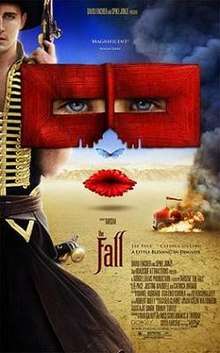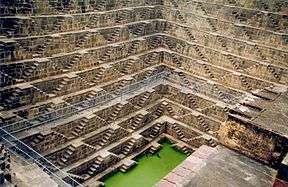The Fall (2006 film)
The Fall is a 2006 adventure fantasy film directed and co-written by Tarsem Singh, starring Lee Pace, Catinca Untaru, and Justine Waddell. It is based on the screenplay of the 1981 Bulgarian film Yo Ho Ho by Valeri Petrov.[3] Its costume design is by Eiko Ishioka. The film was released to theaters in America and the UK in 2008 and earned $3.7 million worldwide.
| The Fall | |
|---|---|
 Theatrical release poster | |
| Directed by | Tarsem Singh |
| Produced by | Tarsem Singh Ajit Singh Tommy Turtle |
| Written by | Tarsem Singh Dan Gilroy Nico Soultanakis |
| Starring | Lee Pace Catinca Untaru Justine Waddell |
| Music by | Krishna Levy |
| Cinematography | Colin Watkinson |
| Edited by | Robert Duffy Spot Welders |
Production company | Radical Media Absolute Entertainment |
| Distributed by | Roadside Attractions |
Release date |
|
Running time | 117 minutes |
| Country | United States India |
| Language | English |
| Budget | $30 million[1] |
| Box office | $3.7 million[2] |
Plot
In 1915 Los Angeles, stuntman Roy Walker (Lee Pace) is hospitalized, bedridden and possibly paralyzed after taking a jump in his first film. He meets Alexandria (Catinca Untaru), a young Romanian-born patient in the hospital who is recovering from a broken arm, and begins to tell her a story about her namesake, Alexander the Great. Alexandria is told she has to leave, but Roy promises to tell her an epic tale if she returns the next day.
The next morning, as Roy spins his tale of fantasy, Alexandria's imagination brings his characters to life. Roy's tale is about five heroes: a silent Indian warrior (Jeetu Verma), a muscular ex-slave named Otta Benga (Marcus Wesley), an Italian explosives expert called Luigi (Robin Smith), Charles Darwin (Leo Bill) with a pet monkey called Wallace, and a masked swashbuckling bandit. An evil ruler named Governor Odious (Daniel Caltagirone) has committed an offense against each of the five, who all seek revenge. The heroes are later joined by a sixth hero, a mystic.
Alexandria vividly imagines her friends and people around her appearing as the characters in Roy's story. Although Roy develops affection for Alexandria, he also has an ulterior motive: by gaining her trust, he tricks her into stealing morphine from the hospital pharmacy. Roy intends to use the morphine to commit suicide because the woman he loves has left him for the actor for whom he provided the stunt footage. However, Alexandria returns with only three pills. For a moment it appears as though she has eaten some of them; in actuality she threw all but three of them down the toilet, having mistaken the "E" on the piece of paper Roy gave her for a "3". The stories become a collaborative tale to which Alexandria also contributes. Alexandria herself becomes a character: while Roy is the masked bandit, she is his daughter.
Roy talks Alexandria into stealing a bottle of morphine tablets locked in a fellow patient's cabinet, and then downs it all. He tells her she should leave after he takes them, but he knows she may not obey and may very well witness the death of the man she has come to view as her father. This does not come to pass, as the next morning Roy awakens from his sleep and realizes he is only alive because his neighboring patient is receiving a placebo rather than actual morphine. Alexandria, desperate to help Roy, sneaks out of bed to the pharmacy. She climbs onto the cabinet but loses her footing, falls, and sustains a severe head injury. She receives surgery, after which she is visited by Roy, where he confesses his deception. He encourages Alexandria to ask someone else to end the story, but she insists on hearing Roy's ending. Roy reluctantly begins the rest of the story.
The heroes die one by one, and it seems that Governor Odious will be triumphant. Alexandria becomes upset, and Roy insists, "It's my story." She declares that it is hers too and exerts some influence on the course of the tale. The epic tale comes to an end with only the Bandit and his daughter remaining alive and Governor Odious dying. But in one final twist, Roy, who has been crafting the story to manipulate Alexandria and cope with his anger, targets the character representing his ex-girlfriend. He blames her for orchestrating the story's pain and suffering as part of a "test" of the Bandit's love for her. The Bandit rejects her as an act of ultimate triumph.
With the story complete, Roy and Alexandria, along with the patients and staff of the hospital, watch a viewing of the finished "flicker" that Roy appeared in. With everyone laughing, only Roy's smile is broken in confusion when he sees that his life-threatening jump has been edited out of the film as another stuntman jumps instead.
Alexandria's arm heals and she returns to the orange orchard where her family works. Her voice-over reveals that Roy has recovered and is now back at work again. As she talks, a montage of cuts from several of silent films' greatest and most dangerous stunts plays; she imagines all the stuntmen to be Roy.
Cast
- Lee Pace as Roy Walker / Black Bandit[4]
- Catinca Untaru as Alexandria / Bandit's daughter
- Justine Waddell as Nurse Evelyn / Sister Evelyn
- Daniel Caltagirone as Sinclair / Governor Odious
- Marcus Wesley as Ice delivery man / Otta Benga
- Robin Smith as One-legged actor / Luigi
- Jeetu Verma as Orange picker / Indian
- Kim Uylenbroek as Doctor / Alexander the Great
- Leo Bill as Orderly / Charles Darwin
- Emil Hostina as Alexandria's father / Blue Bandit
- Julian Bleach as Mystic / Orange picker
- Ronald France as Otto (the "old man")
Themes
The Fall is a self-reflexive film that deals primarily with the concept of storytelling. Roy Walker tells a story to Alexandria, who imagines it, but there is a discontinuity between what he describes and how she sees it. Each character brings their own life into their experiences of the story; Roy takes inspiration from the film that he was working on before his accident, and Alexandria populates his story with familiar sights from her own life. The intimidating X-Ray operator becomes an enemy soldier, the 'Indian' is seen by her as an immigrant co-worker from the orange groves, while Roy's dialogue makes it clear to the audience that he meant 'Indian' to mean a Native American man from the Western film he was involved in.[5]
The Fall is also grounded in the film's historical period. Roy took inspiration for his story's bandits from early 20th century news; the controversy over credit for Charles Darwin's ideas in On the Origin of Species between Darwin and Alfred Russel Wallace, as well as Ota Benga's imprisonment in the Louisiana Purchase Exposition in St. Louis, Missouri were prominent news stories around the time period of the film's setting.[6]
Production
According to the director's remarks on the DVD release of the film, Tarsem Singh largely financed the film with his own funds, determined to make the film according to his own vision, and paid members of the cast and crew on an equal basis rather than in more typical Hollywood fashion.
Singh's commentary indicates the film was made over a period of four years and incorporates footage shot in more than 20 countries, including India, Indonesia (Bali), Italy, France, Spain, Namibia, China (PRC), and numerous others, a few of which are not listed in the credits. Singh stressed the importance of on-location filming and lack of special effects in interviews because he found that modern techniques would not age well in comparison. He reportedly only took advertising jobs in places that he wanted to do location scouting for, and would fly out cast members to shoot scenes for the film using the same crew as he did for commercials.[7] Singh's focus on striking visuals combined with his commitment against using special effects when shooting scenes of the blue city in Jodhpur, as he provided locals with blue paint to refresh the paint on their houses.[8] This alternative to post-production effects resulted in the vibrant blue of the city in the film. Another location, the contemporary South African mental hospital which represents an early 20th-century Los Angeles hospital (the principal setting throughout the film) remained operational (in a separate wing) during filming, according to the DVD commentaries.[9]
The DVD supplementary features reveal that actor Lee Pace remained in a bed for most of the early filming at the director's suggestion, convincing most of the crew that he was in fact unable to walk.[10] The intention, Tarsem and Pace noted, was to maximize the realism of Roy's physical limitations in the eyes of Catinca Untaru, whose lines and reactions as the character Alexandria were largely unscripted, and so were young Catinca's spontaneous interactions with Pace's character. For example, Alexandria's misinterpreting the letter E as the number 3 in a note written by Roy came about from an accidental misreading by the 6-year-old actress during filming, which the director then realized he could adapt into a clever twist in the story.
To further the realism of young Catinca's performance, Tarsem had portions of the hospital scenes between Pace and his young co-star filmed through small holes in the hospital bed curtains, maximizing the youngster's spontaneous interactions with Pace despite the presence of the film crew surrounding them.
Filming locations
- Valkenberg Hospital in Cape Town, South Africa
- Deadvlei from the Sossusvlei dune in Namib-Naukluft National Park in Namibia[11]
- The labyrinth Jantar Mantar in Jaipur
- Lake Palace Hotel in Udaipur, India
- Charles Bridge in Prague, Czech Republic
- Butterfly reef NE of Mana Island, Fiji (Coordinates: -17.672339, 177.131704)
- Ubud, Bali Island, Indonesia
- Andaman Islands of India
- Pangong Tso in Ladakh, India
- Buland Darwaza in the palace complex of Fatehpur Sikri, Uttar Pradesh, India
- Agra[12]
- Magnetic Hill in Ladakh, India
- Moonscape near Lamayuru Monastery in Ladakh, India
- Gunung Kawi, Bali Island, Indonesia
- Chand Baori, a large stepwell in Abhaneri village in the Indian state of Rajasthan
- Jodhpur, the Blue City in Rajasthan
- Umaid Bhawan Palace Lobby, Jodhpur, Rajasthan
- Taj Mahal, India
- Jardín Botánico de Buenos Aires, Argentina
- Jardín Zoológico de Buenos Aires, Argentina
- Teatro Opera Buenos Aires, Argentina
- Capitoline Hill, Colosseum, Roma, Italy
- Hadrian's Villa, Tivoli, Italy
- Hagia Sophia, Istanbul, Turkey
- First Statue of Liberty at Île aux Cygnes in Paris, France[9]
Release
The Fall premiered at the 2006 Toronto International Film Festival. For its theatrical release in 2008, the film was presented by David Fincher and Spike Jonze.
Critical reception
On review aggregator Rotten Tomatoes, the film holds a 61% approval rating based on 107 reviews, with an average rating of 6.25/10. The website's critics consensus reads, "More visually elaborate than the fragmented story can sometimes support, The Fall walks the line between labor of love and filmmaker self-indulgence."[13] Metacritic, which uses a weighted average, assigned the film a score of 64 out of 100 based on 23 critics, indicating "generally favorable reviews".[14]
Roger Ebert gave the film 4/4, and wrote, "You might want to see [it] for no other reason than because it exists. There will never be another like it."[15] Nathan Lee of The New York Times, however, wrote that the film "is a genuine labor of love—and a real bore."[16]
The film appeared on several critics' top ten lists of the best films of 2008. Tasha Robinson of The A.V. Club named it the best film of 2008, Sean Axmaker of the Seattle Post-Intelligencer named it the 6th best film of 2008, and Roger Ebert of Chicago Sun-Times named it among his top 20 films of 2008.[17]
References
- "The Fall". Telegraph (UK). Retrieved 28 April 2020.
- "The Fall". Box Office Mojo. Retrieved 16 October 2015.
- Garrett, Daniel (16 October 2015). "Liberations of Mind, Spirit, and Vision: The Fall by Tarsem Singh". Offscreen. Retrieved 16 October 2015.
- Kehr, Dave (11 May 2008). "Special Effects From the Real World". New York Times. Retrieved 16 October 2015.
- Stevens, Charlotte (2010). "Telling the (Wrong) Story: The disintegration of transcultural communication and narrative in The Fall". Cineaction (80): 30–37.
- Singh, Tarsem. "The Fall- Tarsem's Visual Companion- Part 1: The Director on His Astonishing Imagery". Rotten Tomatoes. Retrieved 30 September 2018.
- "How Tarsem Singh's obsession became a movie". Minnesota Public Radio News. 30 May 2008. Retrieved 30 September 2018.
- Ebert, Roger (3 June 2008). "Tarsem and the legend of "The Fall"". Rogerebert.com. Retrieved 30 September 2018.
- Singh, Tarsem (director) (2006). The Fall (BD commentary).
- Carpenter, Cassie (15 May 2008). "Style meets substance: director Tarsem Singh brings 'The Fall' to theatres after years in the making". Back Stage West. 15 (20). Prometheus Global Media LLC.
- "The Fall – Windows Live". Apanbear.spaces.live.com. Retrieved 11 August 2010.
- "The Fall – a set on Flickr". Flickr.com. Retrieved 11 August 2010.
- "The Fall (2006)". Rotten Tomatoes. Fandango. Retrieved 7 June 2019.
- "The Fall (2006)". Metacritic. CBS Interactive. Retrieved 7 June 2019.
- Ebert, Roger. "The Fall Movie Review & Film Summary". Chicago Sun Times. Retrieved 7 June 2019.
- Lee, Nathan (9 May 2008). "Broken Spirits on the Mend". The New York Times. Retrieved 30 May 2008.
- "Metacritic: 2008 Film Critic Top Ten Lists". Metacritic. Archived from the original on 2 January 2009. Retrieved 11 January 2009.


